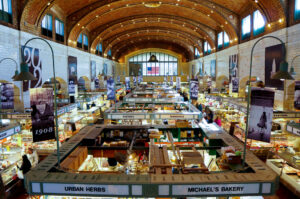On January 30th, 2013, just after Cleveland’s West Side Market celebrated its 100th anniversary, a fire broke out totaling 2 of the 164 vendor stalls and spreading damaging soot throughout the massive structure. This beautiful public marketplace is operated by the City of Cleveland. It was built by the same architects that built the Cleveland Museum of Art, Benjamin Hubbel and W. Dominic Benes. Rising above all the glory stands the 134 feet tall clock tower. The local community depends on the diverse variety of goods that the market offers. News of the total loss of paper products and all food items from the fire was an absolute tragedy.
A local restoration company called RestorX MD had the winning bid and began working around the clock to restore the building. The restoration company reported soot up to an inch thick on top of the overhead lights. The first step for the technicians was to dry clean the dusty soot from any and all surfaces where it collected. This was the most important step taken during the restoration. Had they began cleaning the soot with a liquid cleaning agent, the soot would have actually been set and all of the stainless steel damaged.
After the dry cleaning and a quick soak in a specially formulated cleaning solution, the power washing began with high pressure hot water. Although the building had existing drains, more drainage was required to keep up with the amount of water being used for washing. RestorX MD used the truck mounts from their carpet cleaning division to extract the soot ridden water and haul it away.
Within the soot cleaning process there is always the step of fine detailing. After a fire, no soot can be left behind. Even the smallest amount settled in the cracks between the glass and it’s stainless casing will later cause problems with the steel and persistently harbor a strong odor. Everything must be disassembled, thoroughly cleaned, and reassembled. This is by far the most tedious part of the fire restoration process.
With every restoration, there is a beauty that can be found after the tragedy with the completion of the project. In the case of Cleveland’s Historic Market, vendors restocked by February 18th for the reopening and they were able to resume service in an absolutely pristine building. All of the grime that built up over the 100 years that the building existed had been washed away with all of the soot. Finally, visitors and employees alike were able to again marvel at the beauty of the massive ceramic ceilings and distinct tile details. Thanks to the quick turnaround of an efficient restoration company, the community was able to continue their dependence on the beautiful market, hoping to do so for another 100 years.
Photo courtesy of Landscape Voice
